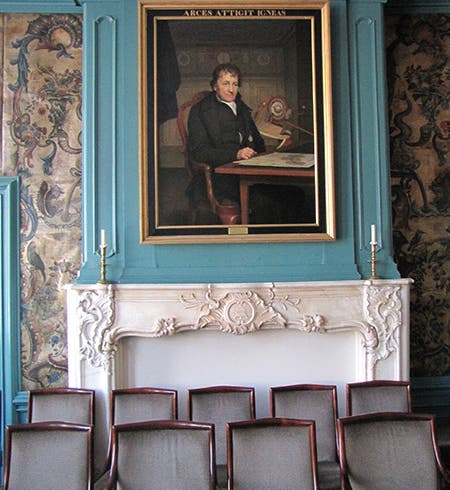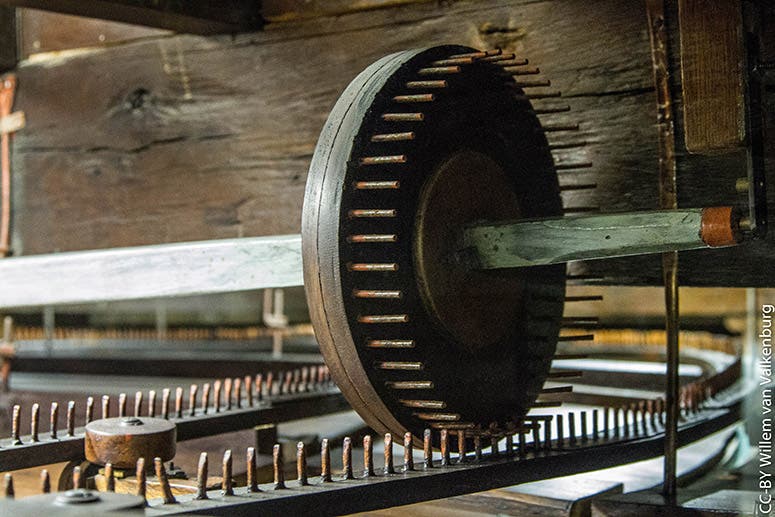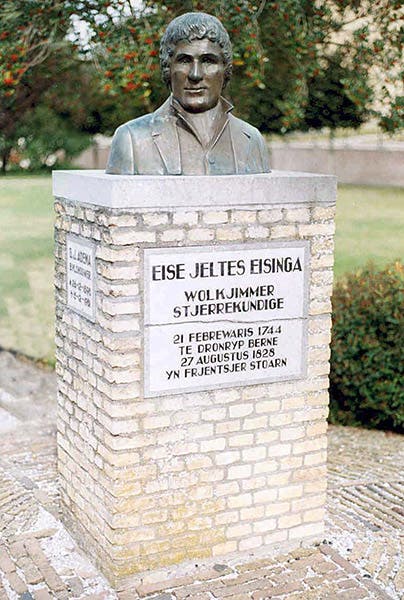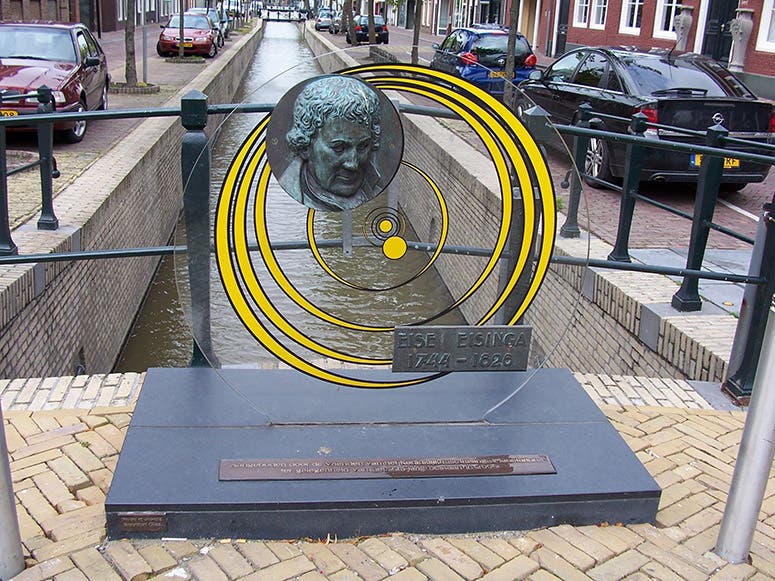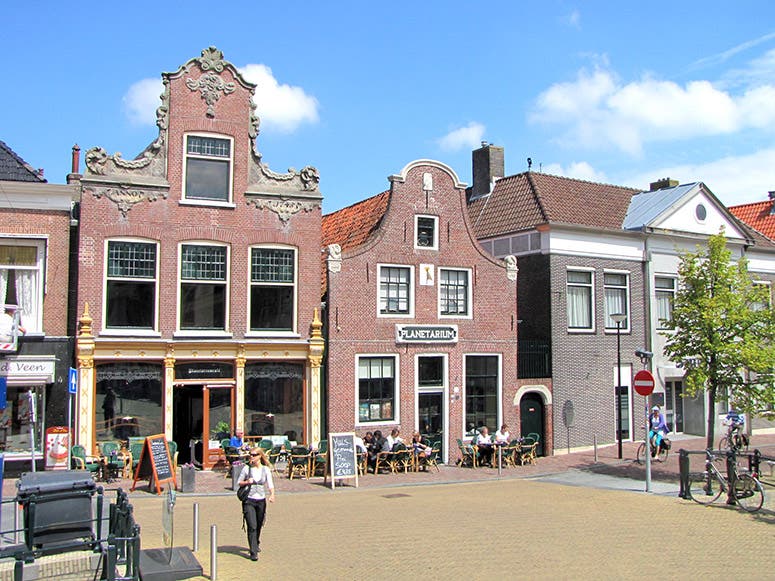Scientist of the Day - Eise Eisinga
Eise Eisinga, a Dutch amateur astronomical instrument maker, was born Feb. 21, 1744. Eisinga is the unlikeliest of homespun scientific heroes. Born in Dronryp, in West Friesland in the northern part of the Netherlands, he had no formal schooling and was trained to be a wool-comber. However, he seems to have taught himself the rudiments of both astronomy and mathematics. And he learned woodworking from his father. He moved to nearby Franeker in 1768 to find work as a wool-comber. In 1774, he began building what he called a planetarium, and we would call an orrery – a device to reproduce the motions of the planets. Most orreries before Eisinga were not large – they would either lie flat on a table, like the original orrery by George Graham, or stand up against a wall, like the orreries of David Rittenhouse. Eisinga had a grander idea. His orrery was installed on the ceiling of a back room in his house, with the mechanism up above, within a false ceiling. The gears are all wooden, with hand-made nails for cogs (hand-made by Eisinga), and the apparatus receives its impulse from a weight-driven pendulum clock. Amazingly, given that the motions of the planets and their moons are somewhat complicated, Eisinga’s planetarium worked well and was quite accurate. In addition to the movement of the planets, it tracked the time of day, the day of the year, and the phases of the moon. Eisinga provided it with a third dimension of sorts, by hanging orbs from the ceiling to represent Sun, Earth, and planets, which move slowly in tune with the actual solar system. And were two other sets of dials and pointers, on the ceiling and one wall, that tracked such things as the day of the week and the ascending and descending nodes of the moon, and much more.
When we say Eisinga had a grander idea, we should be more clear, for in fact Eisinga had never seen an orrery of any kind, or even read about one, before he conceived his own grand version. He did not know the works of Graham, or Rittenhouse, or those of anyone else. His was an orrery de novo.
Eisinga finished his orrery in 1781, just about the time that William Herschel discovered a new planet, Uranus. However, the discovery would not make it into the astronomical textbooks for a few years, and anyway, Eisinga's ceiling was not large enough to accommodate a seventh planet. His planetarium slowly grew in popularity, although there was an eight-year period when Eisinga had to flee Friesland because of a civil war; for some of those years he worked as a wool-comber in nearby Groningen. Being separated from his master creation must have been painful for him. When he returned in 1795, he had to refurbish the planetarium to get it running properly again and it apparently whirled its worlds with great regularity until 1818, when it was visited by King Willem of the Netherlands, who was so impressed that he eventually bought the house and planetarium for the state; this was in 1725, when Eisinga had just three years to live. Some decades later, the state turned the planetarium back over to the city of Franeker, which has maintained it as their primary tourist attraction to the present day. It is the oldest operating orrery/planetarium in the world. Here is a sixty-second video of Franeker, with 30 excellent seconds devoted to Eisinga’s Planetarium.
It is not hard to admire Eisinga, especially when you see photos taken above the ceiling that show the wood-and-nail clockworks that Eisinga made all by himself (with a little help from his Dad), according to plans that he himself drew up (third and fourth images above). It is also hard to fathom the high esteem that Eisinga generates in Netherlanders today. The Dutch have something called “The Canon of Dutch History,” a list of 50 topics, drawn up in 2006, which specifies facets of Dutch history that educators agree should be taught in the Dutch educational system. Some of the topics are general ones, but many are specific: no. 8 is Desiderius Erasmus, 13 is the Dutch East India Company, 18 is Rembrandt, 19 is the Atlas maior of Joan Blaeu, 21 is Christiaan Huygens, 22 Baruch de Spinoza, 33 Vincent van Gogh. And among this distinguished list we can find, right in the middle, number 25: Eise Eisinga. I don’t think many historians outside Holland, if asked to compile a list of distinguished Netherlanders, would put Eisinga in the ranks of Erasmus and Huygens. In fact, I don't think many would have heard of him at all. To the Dutch, apparently, matters are different. He is, it would seem, their Johnny Appleseed, Jim Bridger, and Paul Revere, all rolled into one.
There is a very nice portrait of Eisinga in the Franeker town hall (first image; for a detail of just the portrait, click here), a bust in his home town of Dronryp (fifth image, above), and a relief bronze with a representation of his planetarium on a bridge over a canal somewhere in Friesland (sixth image, above). And there have been several Dutch postage stamps of Eisinga. But his principal monument is his Planetarium, which is indeed an amazing construction, and which we see from the outside just above. May it continue to track the planets for many centuries to come.
Dr. William B. Ashworth, Jr., Consultant for the History of Science, Linda Hall Library and Associate Professor emeritus, Department of History, University of Missouri-Kansas City. Comments or corrections are welcome; please direct to ashworthw@umkc.edu.

